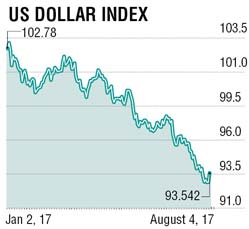
The coming weeks may witness the continuation of rupee’s strength against the US dollar, and therefore, a challenge for the Reserve Bank of India (RBI) to manage the rupee liquidity and external value of rupee. The risk to the above premise is the early contraction of the US Federal Reserve (Fed)'s balance sheet and consequent dollar reverse flows.
As India story is on except for any unforeseen untoward development in the economy, every move northwards for USD/INR should be seen as an opportunity to sell forward and hedge future exports. These levels could be seen attractive by the importers who had been looking to hedge their exposures. USD/INR pair is expected to trade in Rs 63.25 to Rs 64.25 range during the month.
The reasons for this is that the accretion of forex reserves of India over last one year has been $27 billion as on July end this year. Of which, the addition since the beginning of this financial year has been of the order of $23 billion suggesting huge inflows through foreign portfolio investment (FPI) route both in debt as well as equity markets. The forex reserves as on July 28, 2017 stood at $392.9 billion within the kissing distance from the magical number $ 400 billion according to RBI data.

It is interesting to note that in the last 20 years till March 2017, the cumulative net FPI inflows into the Indian debt market has been Rs 2,95,000 crore while the net FPI debt inflow in the first four months alone of this financial year has been Rs 89,000 crore. This compares well with the all-time high figure for a single year (FY 2014-15) of Rs 1,66,000 crore.
As long as these flows remain with the custodian banks, the forex reserves do not get impacted but the domestic currency does. The increase in forex reserves reflects the quantum of intervention by RBI. The side effect of this intervention is the increase in rupee liquidity in the system. Presently, Indian money market is flushed with excess liquidity since demonetization of old currency notes of denomination Rs 500 and Rs 1,000. RBI has been using all the tools at its disposal except raising the cash reserve ratio (CRR) to sterilise the excess rupee liquidity.
Forex intervention aggravates the already existing ample liquidity condition while struggling to leave 'just adequate liquidity' in the system. This complexity is termed as "Managing the Impossible Trinity or Trilemma". Economists Maurice Obstfeld and Alan Taylor made this term "Trilemma" popular while referring to the challenges faced by the central banks to manage exchange rate (external value of domestic currency), free capital flows and the need to have independent monetary policy (the target interest rate) simultaneously.
Indian rupee is gradually appreciating against the US dollar and is presently at a two-year high of 63.58. If the forex inflows continue to follow the present trend in the current month, there is a possibility of rupee testing 63 mark unless RBI decides to intervene massively.
The writer is executive director, Federal Bank